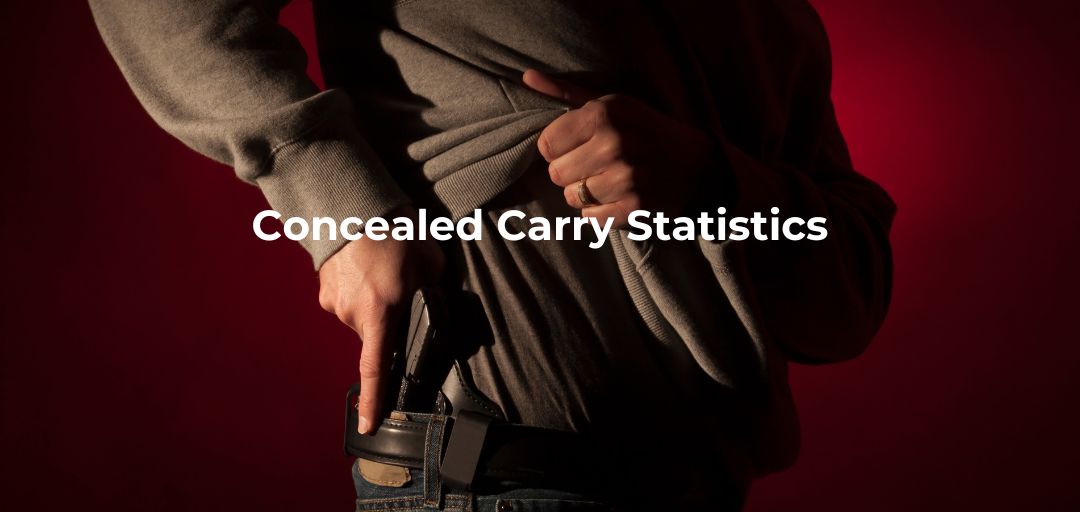In the ongoing debate over gun ownership and personal protection, concealed carry has become a focal point. Supporters of concealed carry argue that it plays a significant role in reducing crime by deterring would-be criminals and allowing law-abiding citizens to defend themselves. In this blog post, we'll answer some of the most frequently asked questions about concealed carry statistics, with a focus on the potential for concealed carry to reduce crime rates. The data suggests that concealed carry can contribute to lower crime rates in many areas, while concealed carry permit holders remain highly law-abiding.
1. How Many People in the U.S. Have Concealed Carry Permits?
The number of people holding concealed carry permits in the U.S. has surged in recent years. Currently, there are over 20 million active concealed carry permits across the country. This figure continues to grow as more states adopt laws that make it easier for law-abiding citizens to obtain permits.
State-by-State Variation
The number of concealed carry permit holders varies significantly from state to state, largely depending on the specific laws and regulations in each area. States like Florida, Texas, and Pennsylvania lead the nation with over 1 million active concealed carry permits each. In contrast, states like New York and California, where concealed carry laws are stricter, have much lower numbers of permit holders.
However, with states shifting toward more permissive concealed carry laws (often called “shall-issue” laws), the number of concealed carry permits has steadily risen across the country. The rise in concealed carry permits coincides with a decrease in violent crime in many states, suggesting that the presence of armed, law-abiding citizens may be acting as a deterrent to potential criminals.
For detailed state-by-state concealed carry statistics, the Crime Prevention Research Center is an excellent resource.
2. What Percentage of Concealed Carry Permit Holders Are Involved in Crimes?
One of the most important questions in the concealed carry debate is whether permit holders contribute to crime. The data consistently shows that concealed carry permit holders are overwhelmingly law-abiding and rarely involved in criminal activity. In fact, research indicates that concealed carry permit holders commit crimes at rates far lower than the general population.
Crime Rates Among Permit Holders
In states like Florida and Texas, where data on concealed carry permit holders is publicly available, studies have shown that the crime rate among permit holders is exceptionally low. For instance, in Florida, the rate of firearm-related crimes committed by permit holders is less than 0.01%. Similarly, in Texas, concealed carry permit holders are convicted of crimes at significantly lower rates than even police officers, who are already among the most law-abiding citizens.
This pattern holds across states that track this data, making it clear that concealed carry permit holders are not contributing to crime. In fact, they may be helping reduce crime by deterring criminals, who are less likely to target individuals they believe may be armed.
You can find more information about crime rates among permit holders in this Crime Prevention Research Center report.
3. Do States with More Concealed Carry Permits Have Lower Crime Rates?
The relationship between concealed carry and crime rates has been the subject of numerous studies. Some research suggests that states with higher numbers of concealed carry permits tend to have lower crime rates, particularly when it comes to violent crimes like robbery, assault, and homicide. This correlation supports the idea that concealed carry helps reduce crime by making criminals think twice before attacking.
Studies on Concealed Carry and Crime Reduction
Proponents of concealed carry often point to the deterrence effect—the idea that criminals are less likely to target individuals or commit violent crimes if they believe their potential victims may be armed. Several studies support this theory. For instance, a study by the National Bureau of Economic Research found that states with higher numbers of concealed carry permits experienced reductions in violent crime over time. Similarly, research from the Crime Prevention Research Center shows that as the number of concealed carry permits has increased, violent crime rates have decreased in many states.
However, it’s important to note that while many studies show a correlation between concealed carry and reduced crime, this remains a topic of debate. Critics argue that other factors, such as improved policing or economic conditions, could also be contributing to these declines. Still, the data shows that concealed carry is likely playing a role in making communities safer.
For more research on this topic, visit the Crime Prevention Research Center.
4. How Have Concealed Carry Laws Changed Over Time?
Over the past few decades, concealed carry laws in the U.S. have undergone significant changes. These changes have largely been in favor of making it easier for law-abiding citizens to obtain permits and carry firearms for self-defense.
From “May-Issue” to “Shall-Issue”
Historically, many states had may-issue laws, which allowed local authorities to exercise discretion over whether to issue a concealed carry permit. This meant that even if an individual met all the legal requirements, they could still be denied a permit based on subjective criteria. In practice, this led to unequal access to permits, with some individuals being denied for reasons unrelated to their qualifications.
In recent years, however, most states have shifted to shall-issue laws. Under shall-issue laws, authorities are required to issue a permit to any applicant who meets the legal requirements, such as passing a background check and completing necessary training. This change has made it much easier for law-abiding citizens to obtain concealed carry permits, contributing to the rise in the number of permit holders across the country.
Constitutional Carry
Some states have gone even further by adopting constitutional carry laws, which allow individuals to carry a concealed firearm without a permit. As of 2024, 27 states have constitutional carry laws in place. These laws are based on the belief that the Second Amendment guarantees the right to carry a firearm without needing government permission.
For more information on the evolution of concealed carry laws, check out this report on concealed carry laws by state.
5. How Often Are Firearms Used in Self-Defense by Concealed Carriers?
A key argument in favor of concealed carry is that it allows individuals to protect themselves in dangerous situations. While it is difficult to track exactly how often firearms are used in self-defense, estimates suggest that firearms are used in self-defense hundreds of thousands of times each year in the U.S.
Defensive Gun Use (DGU) Statistics
According to a study by the Centers for Disease Control and Prevention (CDC), defensive gun use occurs between 500,000 and 3 million times annually in the United States. The wide range of this estimate is due to the fact that many defensive gun uses go unreported, especially in cases where no shots are fired. In many instances, simply brandishing a firearm is enough to stop a crime before it happens.
Criminologist Gary Kleck conducted a study that found similar results, estimating that firearms are used in self-defense approximately 2.5 million times per year. Kleck's research also found that the vast majority of these incidents do not result in the gun being fired, as the mere presence of a firearm is often enough to deter an attacker.
For more detailed statistics on defensive gun use, visit Gun Facts.
Real-Life Examples of Defensive Gun Use
There are countless examples of concealed carry permit holders using firearms to protect themselves and others. Whether it's a homeowner defending their family from an intruder or a bystander stopping an active shooter, these incidents highlight the importance of allowing law-abiding citizens to carry firearms for self-defense.
Conclusion
Concealed carry remains a vital part of personal protection for millions of Americans. The statistics show that concealed carry permit holders are overwhelmingly law-abiding, and there is evidence to suggest that the presence of armed citizens can help reduce crime. As more states adopt shall-issue or constitutional carry laws, and with millions of Americans choosing to carry firearms for self-defense, it is clear that concealed carry plays an important role in making communities safer.
For those interested in learning more about the role of concealed carry in reducing crime, the resources provided in this post offer valuable insights into the data and research surrounding this critical issue.



